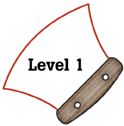
Alaska Science
Key Element B2
A student who meets the content standard will design and conduct scientific investigations using appropriate instruments.
 |
Alaska Science A student who meets the content standard will design and conduct scientific investigations using appropriate instruments. |
|
Performance Standard Level 1, Ages 5–7
|
|
|
|
Sample Assessment Ideas
|
|
|
Expanded Sample Assessment Idea
|
|
Procedure Students will: (allow four weeks)
Reflection and Revision
|
Levels of Performance |
||
|
Stage 4 |
Student work is complete, correct, and shows higher-order thinking skills and relevant knowledge. Measurements are accurate, instruments are chosen without teacher prompt and are used appropriately. | ||
|
Stage 3
|
Student work is generally complete and correct. Measurements are accurate and instruments are used appropriately. There may be some evidence of misconceptions or discrepancies between journal entries and actual observations. | ||
|
Stage 2
|
Student work is mostly incomplete or incorrect. While an attempt was made to grow plants, measurements and observations are inaccurate or incomplete. The student is able to choose correct measuring instruments following teacher prompts. | ||
|
Stage 1
|
Student work is incomplete and incorrect. Attempts to grow plants, if made, do not include measurements or recorded observations. | ||
Standards Cross-References
|
||
|
National Science Education Standards Plan and conduct a simple investigation. In the earliest years, investigations are largely based on systematic observations. (Page 122) Employ simple equipment and tools to gather data and extend the senses. In early years, students develop simple skills, such as how to observe, measure, cut, connect, switch, turn on and off, pour, hold, tie, and hook. Beginning with simple instruments, students can use rulers to measure the length, height, and depth of objects and materials; thermometers to measure temperature; watches to measure time; beam balances and spring scales to measure weight and force; magnifiers to observe objects and organisms; and microscopes to observe the finer details of plants, animals, rocks, and other materials. Children also develop skills in the use of computers and calculators for conducting investigations. (Page 122) Scientific investigations involve asking and answering a question and comparing the answer with what scientists already know about the world. (Page 123) Simple instruments such as magnifiers, thermometers, and rulers provide more information than scientists can obtain using only their senses. (Page 123) |
Benchmarks People can often learn about things around them by just observing those things carefully, but sometimes they can learn more by doing something to the things and noting what happens. (Page 10) Raise questions about the world around them and be willing to seek answers to some of them by making careful observations and trying things out. (Page 285) |
|
Table of Contents | Return to Alaska Native Knowledge Network